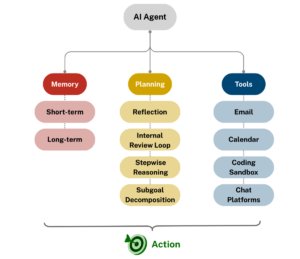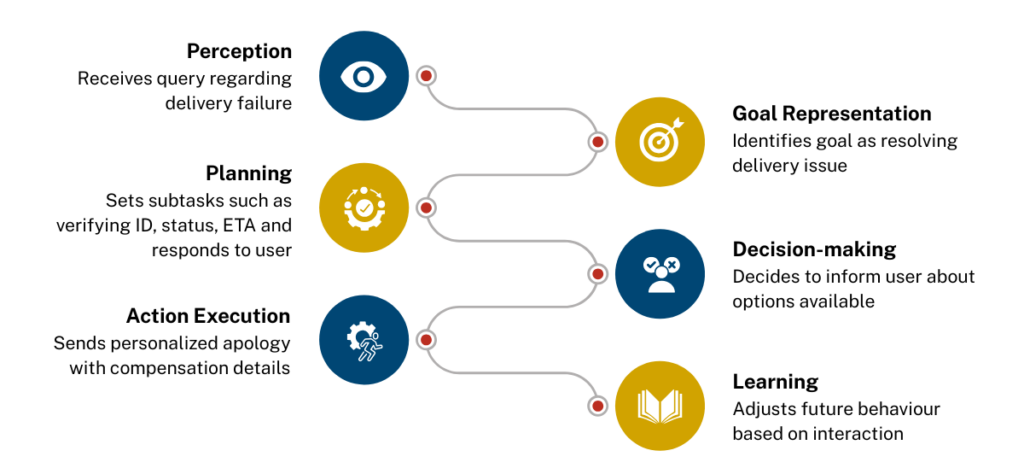Agentic AI is currently one of the most anticipated developments in the AI domain. An AI agent is a model that can understand a particular environment it is put in, make decisions on how to proceed, and then carry out the actions needed to achieve a particular goal. While it is in nascent stages, it holds the promise of greater autonomy and decision-making.
Today, AI models are used for very specific roles, such as content creation or information retrieval. However, AI agents take automation to the next level. The idea is that these systems will be able to orchestrate other systems such as Machine Learning (ML) models, Large Language Models (LLMs), and other software systems to achieve their goals. Hence, there is immense potential to automate entire workflows end-to-end, and remove human dependence in the process.
For example, imagine an AI system that can schedule your calendar, negotiate meeting times, reschedule automatically, and coordinate across platforms like Slack, Zoom, and email.
At a basic level, agentive AI must exhibit the following characteristics:
Dynamic AI agents can take a high-level instruction, and break it down into the necessary steps without any micromanagement.
Imagine asking an LLM to create a launch campaign for a product. The chatbot would probably just create a blog or social media post.
An AI agent will:
AI agents will not need someone constantly feeding them with prompts to get tasks done. It will make decisions on the fly, selecting the right tools, handling exceptions, and reviewing priorities along the way.
An AI agent managing your calendar may:
While LLMs may seem to remember context well, it is only in the scope of a certain chat, or a finite number of tokens. AI agents will have to do better; retaining memory of prior steps, goals, and context across sessions.
If an AI is helping manage a software project, it remembers:
The major factor that will add to these agents’ versatility will be the ability to use external tools. These would include APIs, apps, databases, web-based tools, etc, and allow the system to carry out a diverse set of tasks.
An AI agent may:
Query a database to generate a sales report
AI agents can make sense of complex and real-world scenarios, through contextual understanding, memory, reasoning, and action to achieve their goals.

An agent first starts by making sense of all the inputs given to it, be it visual data, text, audio cues, or hard numbers. The model then translates this raw data into meaningful, structured information. This could be identifying objects within an image, parsing user queries, or reading values from sensors; all needed for higher-level reasoning.
Next, the cognitive layer comes into play, helping the agent realize its objectives. These could be explicit (say, book a flight to London) or implicit (optimize efficiency). This to say that the model’s understanding of its tasks evolve, not just from the user prompts, but also from priorities that evolve dynamically.
Once the goals are understood, the model works on a strategy to achieve them. Plans could be linear or complex nested sub-goals, supported by mechanisms like reflection, internal review, reasoning and subgoal decomposition. The outcome is a flexible context-aware blueprint of action.
The decision engine evaluates possible actions generated during planning and selects the optimal next step. This selection is based on factors such as goal alignment, resource availability, contextual relevance, and past outcomes. The agent may also weigh trade-offs or simulate outcomes to make more robust, adaptive decisions.
Once an action is selected, the execution module carries it out. This may involve physical interactions (in robotic agents), or virtual operations such as composing an email, invoking an API, querying a database, or updating a dashboard. The agent may also monitor results in real time to adjust subsequent actions dynamically.
The learning component allows the agent to continuously improve by analysing its own performance and adapting over time. This may include:
It ensures the agent evolves with changing environments, user preferences, or system feedback.
Let’s see how an agent would deliver upon a goal in a real-world scenario.

Suppose an agent built to assist customers on an ecommerce platform.
Agentic AI as a concept has only gained relevance in the last year or so. While the technology is still in its nascent stages, there are a few use cases where early AI agents are being applied.
The customer service industry is using agents to handle complex customer queries end-to-end. The result is better customer satisfaction with lesser need for human intervention.
End-to-End Support: AI agents can manage entire support journeys without human assistance, right from identifying issues to resolving them. For example, they can detect a delayed order, initiate a replacement, and follow up with the customer to confirm resolution.
Proactive Engagement: Agents are also proving useful in anticipating customer needs pre-emptively. This allows the resolution to be personalized and delivered quicker.
In software development and IT Ops, agentic AI is improving productivity and reducing errors.
Automated Development: AI agents assist in code generation, testing, and deployment, accelerating the software development lifecycle. They can also provide real-time suggestions to improve code quality.
IT Support Automation: Much like customer support, agents help with IT support automation as well, managing requests end-to-end and optimizing performance.
For sales and marketing efforts, agentic helps with automating tasks and personalizing customer interactions in bulk.
Lead Management: Mainly, agents are currently being used in sales to streamline the initial lead generation and reachout processes.
Campaign Optimization: In marketing, agents can help with managing campaigns, helping with content creation efforts across a variety of channels.
Agentic AI is optimizing supply chain and logistics operations by enabling real-time decision-making and predictive analytics.
Predictive Maintenance: By analyzing data from IoT sensors and equipment logs, AI agents can predict potential failures and schedule maintenance proactively, reducing downtime and costs.
Dynamic Logistics: These agents can autonomously adjust delivery routes, manage inventory levels, and respond to disruptions, ensuring efficient and resilient supply chain operations.
In Retail, the major use case is offering personalized shopping experiences for customers. AI agents can recommend products, manage inventory and drive customer support.
eCommerce: Agents can perform product curations for customers, depending on their preferences and purchase history.
Inventory Management: AI can monitor inventory levels in real-time and optimize it to prevent stock-outs.
So what can we expect the future of agentic AI to be? We’re currently in an early exploration phase for this new technology, trying to tackle efficiency and optimization in certain workflows. The overarching goal in this space will be to automate entire processes end-to-end. This will be made possible not by a single agents, but an entire network of such agents being orchestrated by another agent.
The term for such a system is a multi-agent system (MAS), where individual agents, each designed for a specific workflow collaborate to tackle complex tasks. This sort of arrangement is more effective as each agent will be specialized in a specific role, with capability to leverage the right tools for that use case. The output of each such agent combined will lead to effective results.
This will also allow such systems to scale easily, as the necessary agents for different kinds of demand can be onboarded and offboarded easily. Hence, such systems can adapt to new challenges without needing significant redesigns. This will help AI agents reach the autonomy to understand their goals, plan the tasks and then act to provide results without human intervention.